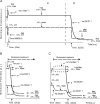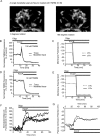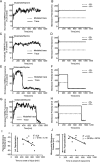Mitochondrial and plasma membrane potential of cultured cerebellar neurons during glutamate-induced necrosis, apoptosis, and tolerance
- PMID: 17670970
- PMCID: PMC6673046
- DOI: 10.1523/JNEUROSCI.1984-07.2007
Mitochondrial and plasma membrane potential of cultured cerebellar neurons during glutamate-induced necrosis, apoptosis, and tolerance
Abstract
A failure of mitochondrial bioenergetics has been shown to be closely associated with the onset of apoptotic and necrotic neuronal injury. Here, we developed an automated computational model that interprets the single-cell fluorescence for tetramethylrhodamine methyl ester (TMRM) as a consequence of changes in either delta psi(m) or delta psi(p), thus allowing for the characterization of responses for populations of single cells and subsequent statistical analysis. Necrotic injury triggered by prolonged glutamate excitation resulted in a rapid monophasic or biphasic loss of delta psi(m) that was closely associated with a loss of delta psi(p) and a rapid decrease in neuronal NADPH and ATP levels. Delayed apoptotic injury, induced by transient glutamate excitation, resulted in a small, reversible decrease in TMRM fluorescence, followed by a sustained hyperpolarization of delta psi(m) as confirmed using the delta psi(p)-sensitive anionic probe DiBAC2(3). This hyperpolarization of delta psi(m) was closely associated with a significant increase in neuronal glucose uptake, NADPH availability, and ATP levels. Statistical analysis of the changes in delta psi(m) or delta psi(p) at a single-cell level revealed two major correlations; those neurons displaying a more pronounced depolarization of delta psi(p) during the initial phase of glutamate excitation entered apoptosis more rapidly, and neurons that displayed a more pronounced hyperpolarization of delta psi(m) after glutamate excitation survived longer. Indeed, those neurons that were tolerant to transient glutamate excitation (18%) showed the most significant increases in delta psi(m). Our results indicate that a hyperpolarization of delta psi(m) is associated with increased glucose uptake, NADPH availability, and survival responses during excitotoxic injury.
Figures








Similar articles
-
A transient inhibition of mitochondrial ATP synthesis by nitric oxide synthase activation triggered apoptosis in primary cortical neurons.J Neurochem. 2001 Apr;77(2):676-90. doi: 10.1046/j.1471-4159.2001.00276.x. J Neurochem. 2001. PMID: 11299330
-
Regulation of glucose transporter 3 surface expression by the AMP-activated protein kinase mediates tolerance to glutamate excitation in neurons.J Neurosci. 2009 Mar 4;29(9):2997-3008. doi: 10.1523/JNEUROSCI.0354-09.2009. J Neurosci. 2009. PMID: 19261894 Free PMC article.
-
Mitochondrial ATP-sensitive potassium channel activation protects cerebellar granule neurons from apoptosis induced by oxidative stress.Stroke. 2003 Jul;34(7):1796-802. doi: 10.1161/01.STR.0000077017.60947.AE. Epub 2003 Jun 5. Stroke. 2003. PMID: 12791941
-
Glutamate excitotoxicity and neuronal energy metabolism.Ann N Y Acad Sci. 1999;893:1-12. doi: 10.1111/j.1749-6632.1999.tb07813.x. Ann N Y Acad Sci. 1999. PMID: 10672225
-
Bioenergetic aspects of apoptosis, necrosis and mitoptosis.Apoptosis. 2006 Apr;11(4):473-85. doi: 10.1007/s10495-006-5881-9. Apoptosis. 2006. PMID: 16532373 Review.
Cited by
-
Mitochondrial potential (ΔΨm) changes in single rat hepatocytes: the effect of orthovanadate nanoparticles doped with rare-earth elements.Eur Phys J E Soft Matter. 2014 Dec;37(12):127. doi: 10.1140/epje/i2014-14127-9. Epub 2014 Dec 24. Eur Phys J E Soft Matter. 2014. PMID: 25533054
-
Comparative analysis of cytosolic and mitochondrial ATP synthesis in embryonic and postnatal hippocampal neuronal cultures.Front Mol Neurosci. 2013 Jan 10;5:102. doi: 10.3389/fnmol.2012.00102. eCollection 2012. Front Mol Neurosci. 2013. PMID: 23335879 Free PMC article.
-
Latrepirdine is a potent activator of AMP-activated protein kinase and reduces neuronal excitability.Transl Psychiatry. 2013 Oct 22;3(10):e317. doi: 10.1038/tp.2013.92. Transl Psychiatry. 2013. PMID: 24150226 Free PMC article.
-
Mechanisms and methods in glucose metabolism and cell death.Methods Enzymol. 2008;442:439-57. doi: 10.1016/S0076-6879(08)01422-5. Methods Enzymol. 2008. PMID: 18662583 Free PMC article.
-
Exploring cells with targeted biosensors.J Gen Physiol. 2017 Jan;149(1):1-36. doi: 10.1085/jgp.201611654. Epub 2016 Dec 27. J Gen Physiol. 2017. PMID: 28028123 Free PMC article. Review.
References
-
- Aarts M, Iihara K, Wei WL, Xiong ZG, Arundine M, Cerwinski W, MacDonald JF, Tymianski M. A key role for TRPM7 channels in anoxic neuronal death. Cell. 2003;115:863–877. - PubMed
-
- Almeida A, Heales SJ, Bolanos JP, Medina JM. Glutamate neurotoxicity is associated with nitric oxide-mediated mitochondrial dysfunction and glutathione depletion. Brain Res. 1998;790:209–216. - PubMed
-
- Ankarcrona M, Dypbukt JM, Bonfoco E, Zhivotovsky B, Orrenius S, Lipton SA, Nicotera P. Glutamate-induced neuronal death: a succession of necrosis or apoptosis depending on mitochondrial function. Neuron. 1995;15:961–973. - PubMed
-
- Atlante A, Gagliardi S, Minervini GM, Marra E, Passarella S, Calissano P. Rapid uncoupling of oxidative phosphorylation accompanies glutamate toxicity in rat cerebellar granule cells. NeuroReport. 1996;7:2519–2523. - PubMed
-
- Bano D, Young KW, Guerin CJ, Lefeuvre R, Rothwell NJ, Naldini L, Rizzuto R, Carafoli E, Nicotera P. Cleavage of the plasma membrane Na+/Ca2+ exchanger in excitotoxicity. Cell. 2005;120:275–285. - PubMed
Publication types
MeSH terms
Substances
LinkOut - more resources
Full Text Sources
Other Literature Sources
